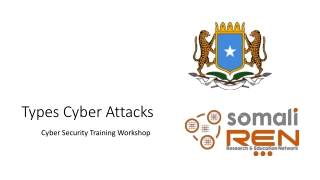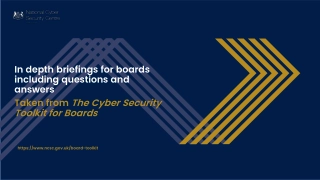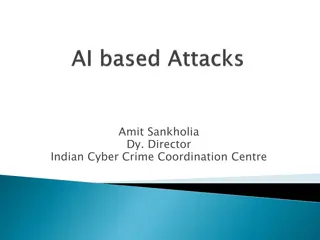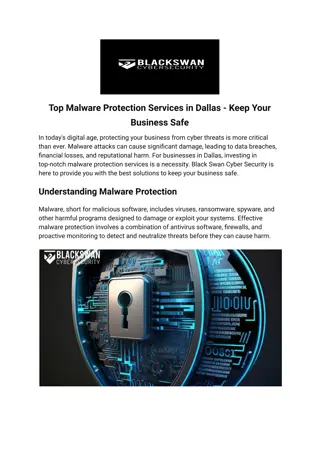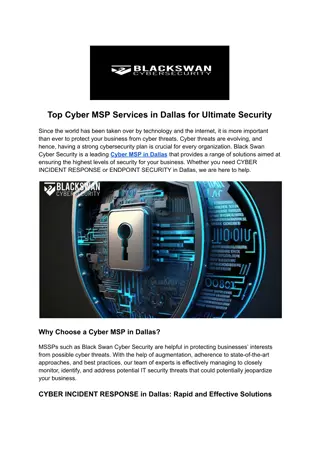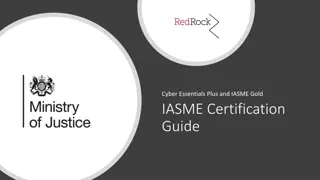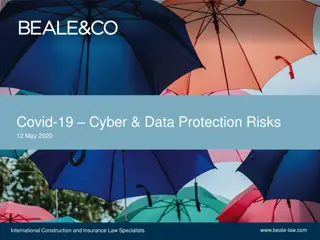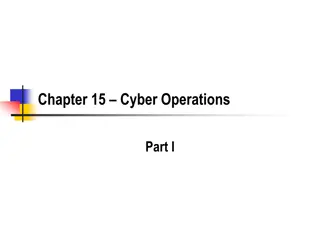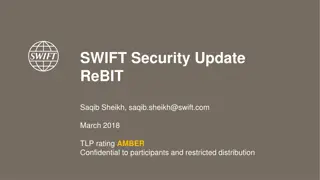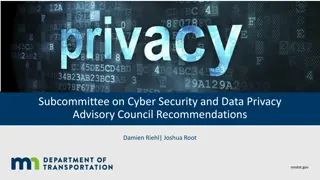Importance of Cyber Security in Protecting Data
Cyber security is crucial for safeguarding data from theft and damage, including sensitive information like PII and PHI. Without a solid cyber security program, organizations become vulnerable to data breaches, making them targets for cyber criminals and jeopardizing industry information systems. Learn about the goals and principles of information security and real-time cyber attacks to understand the significance of cyber security measures.
Download Presentation

Please find below an Image/Link to download the presentation.
The content on the website is provided AS IS for your information and personal use only. It may not be sold, licensed, or shared on other websites without obtaining consent from the author.If you encounter any issues during the download, it is possible that the publisher has removed the file from their server.
You are allowed to download the files provided on this website for personal or commercial use, subject to the condition that they are used lawfully. All files are the property of their respective owners.
The content on the website is provided AS IS for your information and personal use only. It may not be sold, licensed, or shared on other websites without obtaining consent from the author.
E N D
Presentation Transcript
CONTENT 1. INTRODUCTION 2. ELEMENTS OF INFORMATION SECURITY 3. SECURITY POLICY 4. SECURITY TECHNIQUES 5. STEPS FOR BETTER SECURITY 6. CATEGORY OF COMPUTER SECURITY 7. THE OPERATIONAL MODEL OF N/W SECURITY 8. BASIC N/W SECURITY TERMINOLOGY 9. THREATS A ND VULNERABILITY 10. DIFFERENCE BETWEEN SECURITY AND PRIVACY 11. SECURITY ATTACKS
INTRODUCTION Cyber is a prefix that denotes a relationship with information technology (IT). Anything relating to computing, such as the internet, falls under the cyber category Network security It is designed to to protect networling components, connections and contents. Information Security-To protect confidentiality, integrity and availability of information assets, whether in storage, processing or transmission Physical security-physical access to the computer system and networks is restricted only to authorized users Data seciurity-Protecting data from unauthorized disclosure and modification
Why we need cyber security? Cyber security is important because it protects all categories of data from theft and damage. This includes sensitive data, personally identifiable information (PII), protected health information (PHI), personal information, intellectual property, data, and governmental Without a cyber security program, your organization cannot defend itself against data breach campaigns, which makes it an irresistible target for cyber criminals and industry information systems
Some real time attacks Russian Attacker Maxim actually manage to intruder into a merchant Internet site & obtained 300,000 credit card numbers from its DB. He then attempted extortion by demanding protection money($100,000) from the merchant. The merchant refused to oblige. Following this, the attacker published about 25,000 of the credit card numbers on the internet! Some banks reissued all the credit cards at a cost of $20 per card & others forewarned their customers about unusual entries in their statements.
Goalsor principles of information security The goals of information security are confidentiality, integrity and availability Confidentiality The purpose of the confidentiality principle is to keep personal information private and to ensure that it is visible and accessible only to those individuals who own it or need it to perform their organizational functions. Integrity Consistency includes protection against unauthorized changes (additions, deletions, alterations,etc.) to data. The principle of integrity ensures that data is accurate and reliable and is not modified incorrectly, whether accidentally or maliciously. Availability Availability is the protection of a system s ability to make software systems and data fully available when a user needs it (or at a specified time). The purpose of availability is to make the technology infrastructure, the applications and the data available when they are needed for an organizational process or for an organization s customers.
Elements of information security 1. Physical security Physical security is the protection of personnel, hardware, software, networks and data from physical actions and events that could cause serious loss or damage to an enterprise, agency or institution. This includes protection from fire, flood, natural disasters, burglary, theft, vandalism and terrorism. Physical attacks can cause a safe area to break into or the invasion of a restricted area part. An attacker can easily damage or steal critical IT assets, install malware on systems, or leave a remote access port on the network. It is important to have strict physical security to protect against external threats, as well as equally effective measures to avoid the risks of any internal intruder. The key is to understand that physical security refers to the entire space, and it should not be restricted only to the front door, but to the entire building. Any area that is left unprotected such as the smoking area (with doors for example facing the outside of the building, without the main entrance controls) or the entrance to the car park, can pose a risk. Security experts refer to this form of protection as a deep or layered protection, since there are several control points in the physical infrastructures. Physical damage is as harmful as digital loss, and therefore strict physical security measures must be taken
System elements System is updated on regular basis with license copy of antivirus to protect from viruses. Malicious software detection is installed on all machines. All the user machines have user account and an administrator account.Changes to the particuler software is done through administrative account only. When user goes on leave, his or her account is disabled even if account is inactive for specific period of time are also disabled.
Disable allthe USB ports and CD drives to avoid unwanted data transfer and viruses infected programs through such drive. Maintain the logs of network activities. 3.Process element Any information stored accessible to authorised user only. Access right of sensitive information given to those who were signed the Service Level Agreement and non Disclosure/ Confidentiality Agreement . A detailed list of all software and their usage is maintained Proper monitoring and review of all activities is maintained on regular basis
SECURITY POLICY A security policy is a document that states in writing how a company plans to protect its physical and information technology (IT) assets A security policy must identify all of a company's assets as well as all the potential threats to those assets. Company employees need to be kept updated on the company's security policies. The policies themselves should be updated regularly as well
Following general questions should be addressed clearly and concisely in any security policy What is the reason for the policy? Who developed the policy? Who approved the policy? Whose authority sustains the policy? Which laws or regulations, if any, are the policy based on? Who will enforce the policy? How will the policy be enforced? Whom does the policy affect? What information assets must be protected? What are users actually required to do? How should security breaches and violations be reported? What is the effective date and expiration date of the policy?
Techniques One way to keep files and data safe is to use encryption. This is often used when data is transferred over the Internet, where it could potentially be seen by others. Encryption is the process of encoding messages so that it can only be viewed by authorized individuals. An encryption key is used to make the message unreadable, and a secret decryption key is used to decipher the message.. Encryption is widely used in systems like e-commerce and Internet banking Encryption One widely used strategy to improve system security is to use a firewall. A firewall consists of software and hardware set up between an internal computer network and the Internet. A computer network manager sets up the rules for the firewall to filter out unwanted intrusions. These rules are set up in such a way that unauthorized access is much more difficult. Firewall A system administrator can decide, for example, that only users within the firewall can access particular files, or that those outside the firewall have limited capabilities to modify the files. You can also set up a firewall for your own computer, and on many computer systems, this is built into the operating system. The most widely used method to prevent unauthorized access is to use passwords. A password is a string of characters used to authenticate a user to access a system. The password needs to be kept secret and is only intended for the specific user. In computer systems, each password is associated with a specific username since many individuals may be accessing the same system. Passwords Data backup is the practice of copying data from a primary to a secondary location, to protect it in case of a disaster, accident or malicious action Data backup Antivirus software (abbreviated to AV software), also known as anti-malware, is a computer program used to prevent, detect, and remove malware. Antivirus software was originally developed to detect and remove computer viruses, hence the name. However, with the proliferation of other malware, antivirus software started to protect against other computer threats. Some products also include protection from malicious URLs, spam, and phishing Anti Virus
Steps for better Security Security is the most important aspect of computer world Following r the steps one should follow:- Assets:- Decide, Identify, Protect Risks:- identify threats, attacks, vulnerabilities, exploits, theft Protection:- find out the solutions Tools & Technique:- select Priorities:- decide the order of tools
CATEGORY OF COMPUTER SECURITY 1. Cryptography:- Mathematical scrambling of data. 2. Data Security:- Protective measures, keep safe from un- authorized access, privacy, prevent breaches , etc. 3. Computer Security Model:- It Depends on computer architecture, specification, security issues, protection mechanism. Act as a framework for information system security policy. 4. Network Security:- Protection during transmission, Policies & provision by Admin, Authorization & Access Control
Any security service would have the three components discussed below: 1. Transformation of the information which has to be sent to the receiver. So, that any opponent present at the information channel is unable to read the message. This indicates the encryption of the message. It also includes the addition of code during the transformation of the information which will be used in verifying the identity of the authentic receiver.
2.Sharing of the secret information between sender and receiver of which the opponent must not any clue. Yes, we are talking of the encryption key which is used during the encryption of the message at the sender s end and also during the decryption of message at receiver s end. 3. There must be a trusted third party which should take the responsibility of distributing the secret information (key) to both the communicating parties and also prevent it from any opponent.
Basic N/W Security Terminology Unauthorized access An unauthorized access is when someone gains access to a server, website, or other sensitive data using someone else's account details. Hacker Is a Person who tries and exploits a computer system for a reason which can be money, a social cause, fun etc. Threat Is an action or event that might compromise the security. Vulnerability It is a weakness, a design problem or implementation error in a system that can lead to an unexpected and undesirable event regarding security system. Attack Is an assault on the system security that is delivered by a person or a machine to a system. It violates security. Antivirus or Antimalware Is a software that operates on different OS which is used to prevent from malicious software. Social Engineering Is a technique that a hacker uses to stole data by a person for different for purposes by psychological manipulation combined with social scenes. Virus It is a malicious software that installs on your computer without your consent for a bad purpose. Firewall It is a software or hardware which is used to filter network traffic based on rules.
Plain Text : An original / intelligible message or data Cipher text: coded message Enciphering/Encryption: process of converting plain text to cipher text Deciphering/ Decryption: restoring the plain text from the ciphertext Key: the secret material used for performing encryption
Passive Attacks Passive Attacks A passive attack makes an attempt to collect information from the system but does not modify or alter the system data or resources. Eavesdropping or monitoring of information is an example of passive attacks. Passive Attacks A passive attack makes an attempt to collect information from the system but does not modify or alter the system data or resources. Eavesdropping or monitoring of information is an example of passive attacks.
Active Attacks Active attacks involve modification of a data stream or creation of a false stream of messages. The attacker s aim in such type of attack is to corrupt or destroy the data as well as the network itself.
Types of active attacks are as follows: Masquerade Modification of messages Repudiation Replay Denial of Service
Masquerade A masquerade attack takes place when one entity pretends to be a different entity.
Modification of messages It means that some portion of a message is altered or that message is delayed or reordered to produce an unauthorized effect. For example, a message meaning Allow JOHN to read confidential file X is modified as Allow Smith to read confidential file X .
Repudiation This attack occurs when the network is not completely secured or the login control has been tampered with. With this attack, the author s information can be changed by actions of a malicious user in order to save false data in log files, up to the general manipulation of data on behalf of others, similar to the spoofing of e- mail messages.
Replay It involves the passive capture of a message and its subsequent transmission to produce an authorized effect. In this attack, the basic aim of the attacker is to save a copy of the data originally present on that particular network and later on use this data for personal uses. Once the data is corrupted or leaked it is insecure and unsafe for the users.
Denial of Service It prevents the normal use of communication facilities. This attack may have a specific target. For example, an entity may suppress all messages directed to a particular destination. Another form of service denial is the disruption of an entire network either by disabling the network or by overloading it with messages so as to degrade performance.
Threat A cyber threat is a malicious act that seeks to steal or damage data or discompose the digital network or system. Threats can also be defined as the possibility of a successful cyber attack to get access to the sensitive data of a system unethically. Examples of threats includecomputer viruses, Denial of Service (DoS) attacks, data breaches, and even sometimesdishonest employees.
Types of Threat Threats could be of three types, which are as follows: Intentional- Malware, phishing, and accessing someone s account illegally, etc. are examples of intentional threats. Unintentional- Unintentional threats are considered human errors, for example, forgetting to update the firewall or the anti-virus could make the system more vulnerable. Natural- Natural disasters can also damage the data, they are known as natural threats.
Vulnerability: In cybersecurity, a vulnerability is a flaw in a system s design, security procedures, internal controls, etc., that can be exploited by cybercriminals. In some very rare cases, cyber vulnerabilities are created as a result of cyberattacks, not because of network misconfigurations. Even it can be caused if any employee anyhow downloads a virus or a social engineering attack.
Types of Vulnerability Vulnerabilities could be of many types, based on different criteria, some of them are: Network- Network vulnerability is caused when there are some flaws in the network s hardware or software. Operating system- When an operating system designer designs an operating system with a policy that grants every program/user to have full access to the computer, it allows viruses and malware to make changes on behalf of the administrator. Human- Users negligence can cause vulnerabilities in the system. Process- Specific process control can also cause vulnerabilities in the system.
Difference between Data Privacy and Data Security : Data Privacy Data Security Data Privacy is all about the reflection of what data is important and why. Data Security is all about the reflection of how those policies got enforced. 1 Data privacy sets about proper usage, collection, retention, deletion, and storage of data. Data security sets the policies, methods, and means to secure personal data. 2 Data security gives prerequisite to data privacy. Data security is the main prerequisite to data privacy. 3 It offers to block websites, internet browsers, cable companies, and internet service providers from tracking your information and your browser history. It offers to protect you from other people accessing your personal information and other data. 4 Data Privacy basically governs how data is collected, shared and used. Data Security basically protects data from compromise by external attackers and malicious insiders. 5 Data privacy tools include browser extensions and add-on, password managers, private browsers and email services, encrypted messaging, private search engines, web proxies, file encryption software, and ad and tracker blockers. Data Security tools involve with identity and access management, data loss prevention, anti-malware, anti-virus, event management and data masking software. 6 It doesn t include the encryption format. It includes the encryption and breach response. 7 For e.g. The European Union s General Data Protection Regulation is an type of international standard for protecting the privacy of EU citizens. For e.g. The Payment Card Industry Data Security Standard is a set of rules which protect the sensitive payment card information and cardholder data. 8
References: Dr. V.K. Pachghare, Cryptography and Information Security, PHI,ISBN 978-81-303-5082-3 Atul Kahate, Cryptography and Network Security, Tata McGraw Hill,ISBN 978-0-07-064823-4 Further Reading use ppt safter this slide


